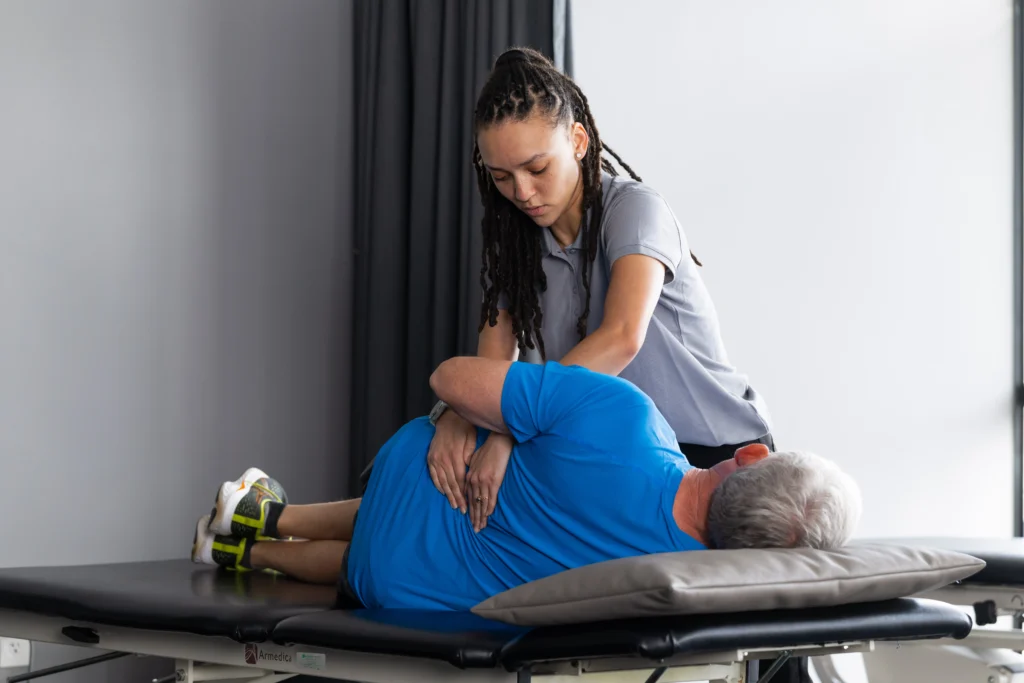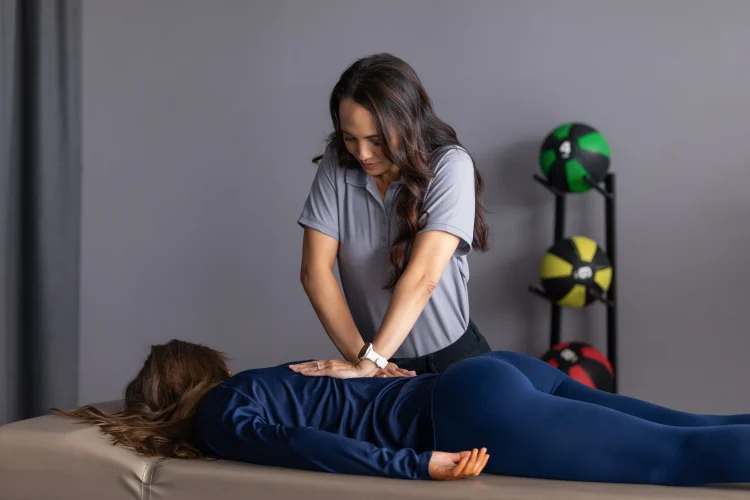[tsf_breadcrumb sep="/" class="breadcrumbs]
Home / Patients / Conditions We Treat / Back Pain
Back pain is one of the most common reasons people seek medical care, and it can significantly impact daily life and overall well-being. This comprehensive guide explores the essential role of physical therapy (PT) in treating and recovering from back pain. Whether you’re dealing with acute discomfort or chronic pain, PT offers evidence-based techniques to reduce pain, restore function, and improve overall quality of life. By understanding how personalized treatment plans, targeted exercises, and expert guidance can support your recovery, you’ll be empowered to take proactive steps towards lasting relief and improved mobility.
Back pain is typically defined as discomfort or pain experienced anywhere along the spine, from the base of your neck to your lower back, and can range from a dull, persistent ache to a sharp, acute pain.1 Both of which limit mobility and function. According to the World Health Organization, nearly 619 million individuals globally suffer from low back pain, and it is the leading cause of disability in adults under the age of 45.2 It is also the largest population of people who would benefit from physical rehabilitation. In the US alone, it is estimated that approximately 80% of adults will experience some form of back pain during their lifetime. Anyone can experience back pain; however, prevalence increases with age and back pain is most commonly seen in those aged 50-55 and is more common in women.
This widespread condition not only disrupts work and functional mobility but also takes a financial and emotional toll on the individual and healthcare systems. Whether the source of pain originates from poor posture, an acute injury, chronic conditions-such as degenerative joint disease, or a sedentary lifestyle, back pain can significantly impact the quality of one’s life. As a result, effective, patient centered and evidence based interventions such as PT have become essential in managing symptoms, improving mobility, and aiding individuals in returning to their prior level of function (PLOF).
Back pain can stem from a variety of sources, ranging from mechanical issues to structural problems, and sometimes the exact cause isn’t clear.3 Understanding these causes is crucial to the development of an effective treatment plan. Below are a few of the most common causes of back pain.
Nonspecific/Mechanical Back Pain (90% cases)
Specific/Structural Spinal Pathology
Inflammatory Spinal Conditions
Spinal Red Flag Conditions
Referred/Visceral Pain

Several lifestyle and health-related factors can increase an individual’s likelihood of developing back pain.4 These often interact and compound the problem if left untreated. Below are the most common risk factors associated with back pain.
In some cases, back pain may be a symptom of an underlying condition that requires a specialized treatment approach.5 Those include but, are not limited to:
Back pain is associated with a wide range of symptoms and is often dependent on the root cause of the pain.6 Back pain can be localized or widespread throughout the entire back. Some of the most common symptoms reported by those suffering from back pain include:
To best understand and treat your pain, contacting a skilled physical therapy can be crucial as PTs are trained to identify any red flag symptoms and are knowledgeable on when and to whom a patient should be referred.
The diagnosis of back pain requires a thorough evaluation in order to develop a patient centered, individualized treatment plan. If you are experiencing pain that is so severe it limits your ability to perform activities of daily living (ADLS) or has lasted longer than a month, it might be time to visit a physical therapist (PT).
As with the diagnosis of many conditions, a PT will begin with an in depth evaluation. This typically begins with obtaining a thorough past medical history in which they will collect information regarding the onset, location, duration, intensity of the pain as well as any aggravating or alleviating factors as well as any possible underlying conditions. A PT will also conduct a physical exam in which they assess the strength and range of motion (ROM) of the spine and surrounding structures. You might be asked to perform certain tasks to reproduce your pain. If nerve involvement is suspected, a PT might also conduct a neurological screening such as reflexes or sensation. Based upon the findings from this assessment, a PT will create a personalized treatment plan that targets the specific needs and goals of the patient.
If the pain persists or worsens, a PT might refer you to a physician to undergo further diagnostic tests. Diagnosing back pain often prompts the use of MRIs or X-rays when the source of pain is unclear. However, these tools are frequently overused. Unless you have red flags such as significant trauma or neurological symptoms, early imaging can sometimes do more harm than good and therefore, contacting a PT first is a smart move.
It’s essential to understand that just because you are experiencing pain doesn’t necessarily mean that there is any underlying tissue damage and that tissue damage does not always lead to pain. For instance, a large systemic review found that degenerative disc changes appear in 37% of 20 year-olds and up to 96% of 80 year-olds have had no back pain whatsoever.7 Additionally, research indicates that patients subjected to early imaging without a clear clinical need often experience longer recovery times than those who did not.8

When it comes to the treatment of back pain there are a variety of options that depend upon the underlying cause, severity, and the individual’s unique goals. Understanding both the non-surgical and surgical options available to you can help you make an informed decision on what is the most appropriate course of action for you and your goals.9
Discuss with your PT if surgery is warranted based upon your symptoms including, new or worsening bladder/bowel issues, severe numbness/ tingling in legs or feet, gait or balance abnormalities, or if the pain has not improved with conventional treatment such as physical therapy. There are a variety of surgical options, some of which are listed below.

Although not all cases of back pain can be avoided, many can be prevented through lifestyle modification and establishing healthy habits that focus on spinal health and overall physical well-being. By making small, consistent lifestyle changes you can significantly reduce the risk of developing or exacerbating back pain. Below are a few tips to help you maintain a healthy spine!
Living with back pain can be challenging but it does not need to be debilitating. There are various effective strategies that can be utilized to manage symptoms that allow you to live a pain free life. We have discussed numerous strategies- such as lifestyle modification and physical therapy, to guide you in making informed decisions when it comes to how you manage your back pain. Additional coping strategies include mindfulness techniques- such as meditation or tai-chi, utilization of braces, aquatic therapy, or support groups.14
Coping with chronic back pain involves a combination of lifestyle adjustments, pain management techniques and ongoing support. During flare ups it’s important to incorporate gentle movement within the limits of your pain. It is also important to remember that what works for one person might not work for another.
Long term health and well being can be supported by maintaining a regular exercise routine that incorporates both strengthening and mobility activities. Managing both emotional and physical stress is also key to maintaining a healthy spine. If you are suffering from back pain whether it be from an injury or an underlying condition- seeking out a physical therapist can play a critical role in reducing your symptoms and improving your quality of life. Taking this proactive step can lead to lasting relief and a healthy, happy spine.
Physical therapy is a cornerstone of effective, long-term back pain management. A skilled physical therapist- after performing a thorough evaluation, which we discussed earlier in this article, will address the root cause of pain through movement, patient education, and hands-on care. At Confluent Health, we aim to create individualized plans that include manual therapy, neuromuscular re-education, targeted strength and mobility exercises, and modalities such as dry needling or electrical stimulation.15 The goal of our visits is to reduce pain, restore function, and prevent future exacerbations while reducing the need for medication or surgical intervention.

With direct access, you can immediately see a physical therapist without a physician referral.
Yes, physical therapy can be highly effective in treating back pain through education, exercise, and hands-on techniques to relieve pain.
While back pain can become chronic, it does not have to become permanent. Your physical therapist will design a plan to get you out of pain.
As mentioned throughout this article, back pain can present in several ways and there are numerous causes. The three main categories are acute (a few days to a few weeks), subacute (4-12 weeks), and chronic (longer than 12 weeks and occurs on a daily basis) back pain.16
Yes, back pain can go away on its own especially if it is acute and mild to moderate pain. In fact, most acute pain- pain that is due to strain or sprain – improves with rest and gentle movement. However, this is dependent on the root cause and severity of the pain. While many recover on their own, early intervention can improve recovery time and prevent the development of a chronic issue.
If you are experiencing persistent back pain that interferes with your daily life, don’t wait any longer – take control of your spinal health today. At Confluent Health, our skilled physical therapists are here to help you live a pain free life by providing a personalized plan that is tailored to your needs and goals. Schedule a consultation with us today!